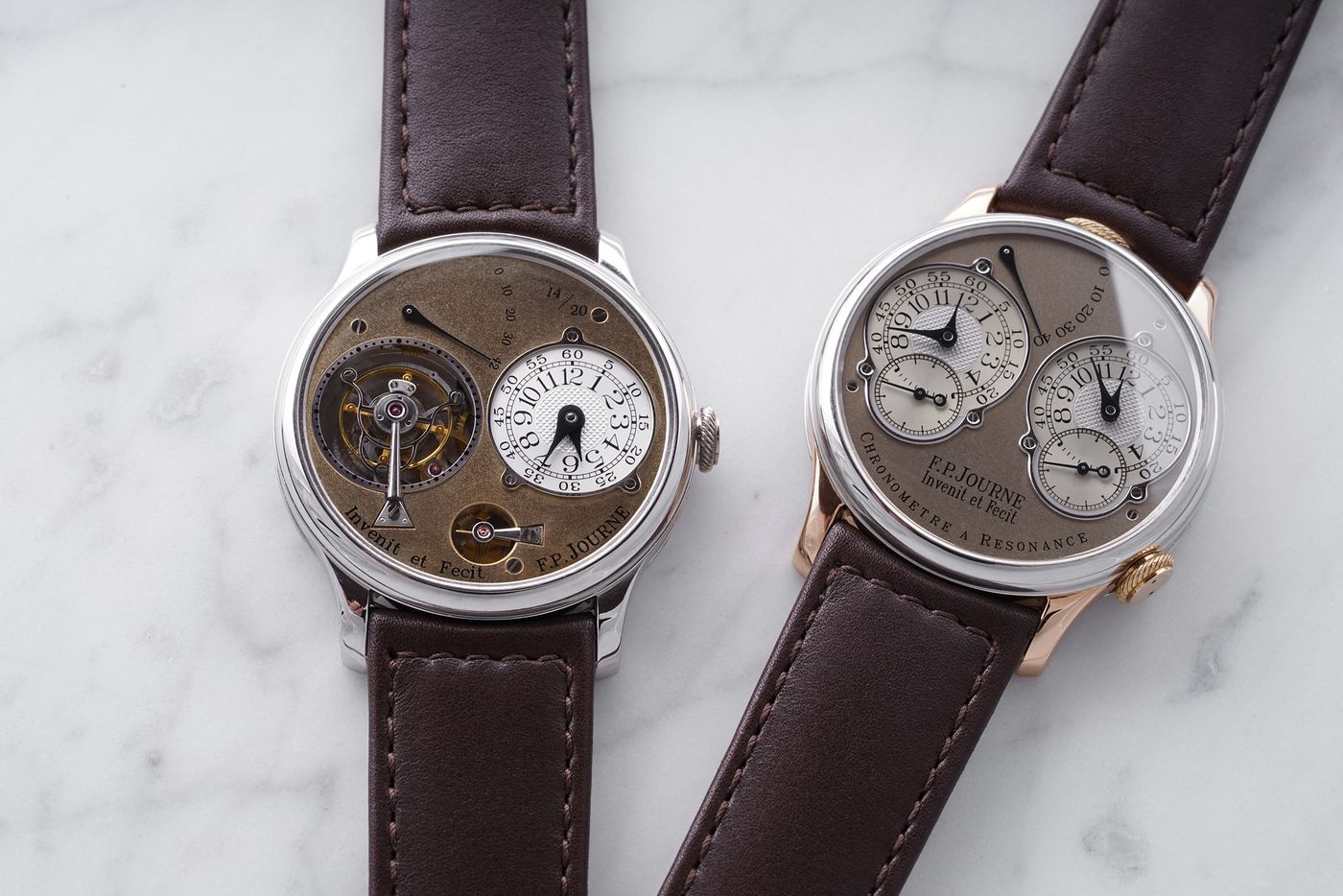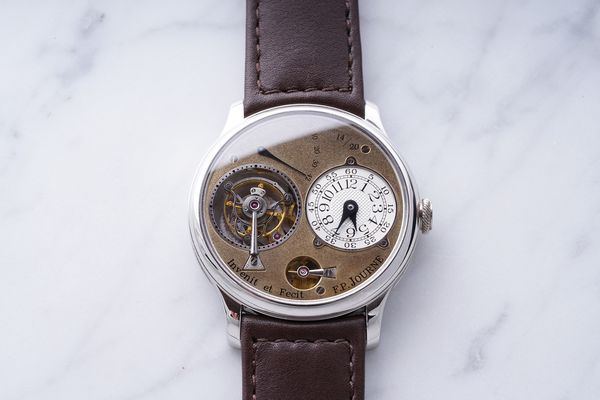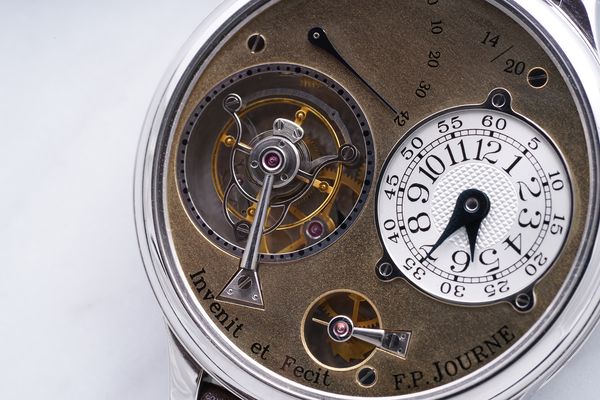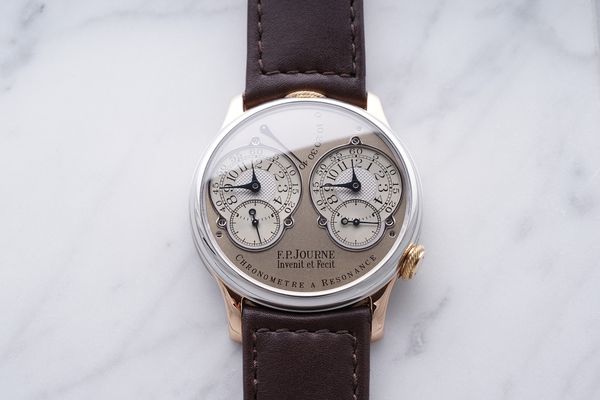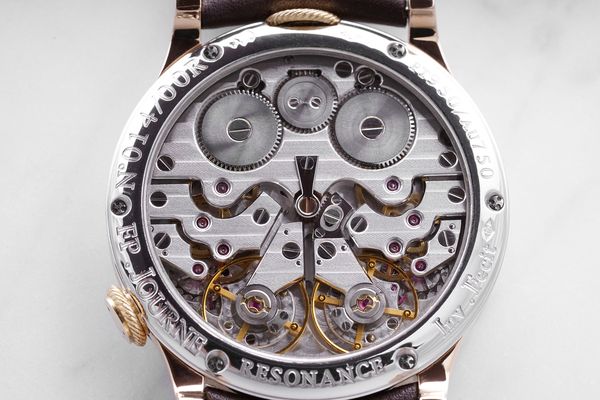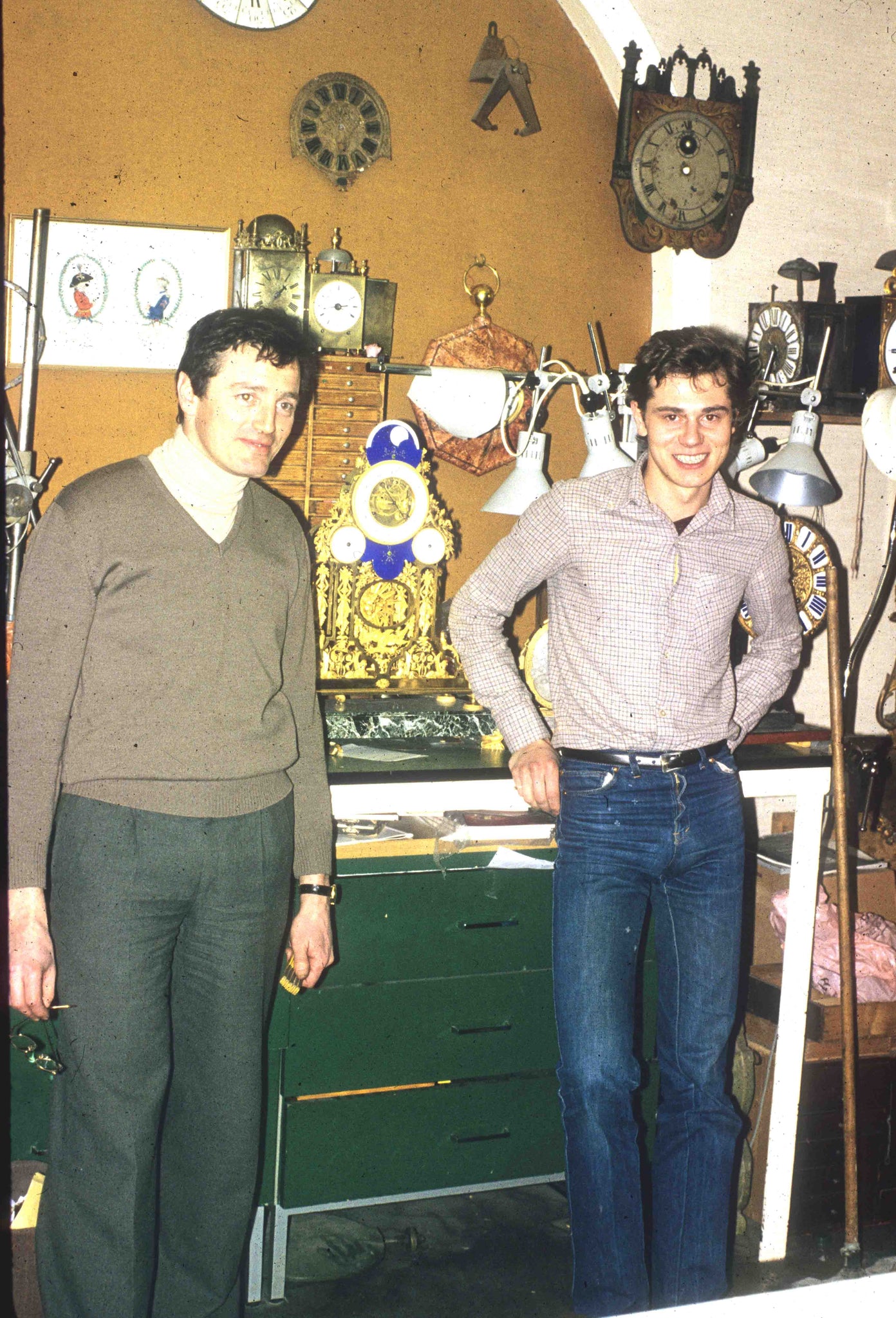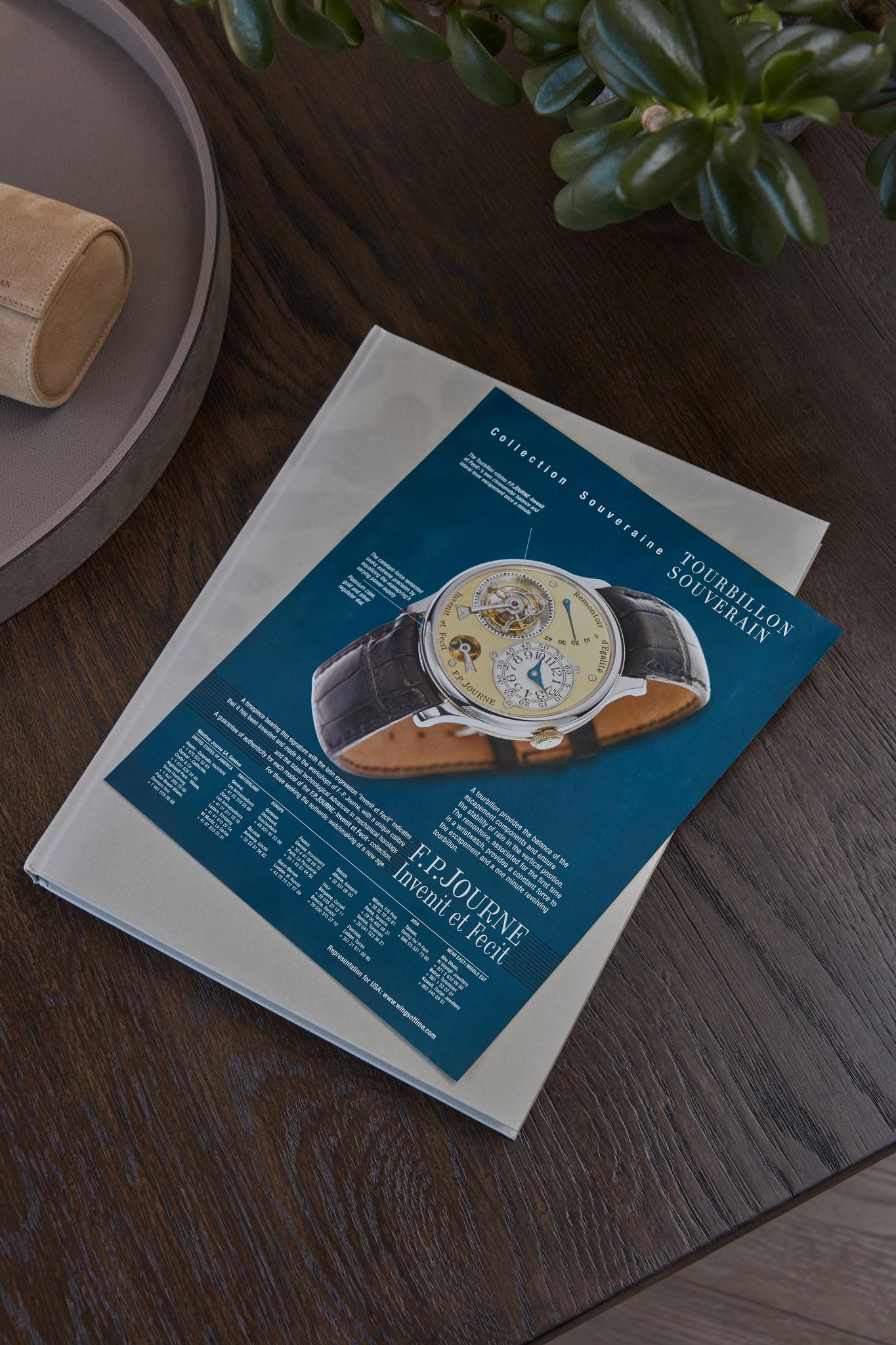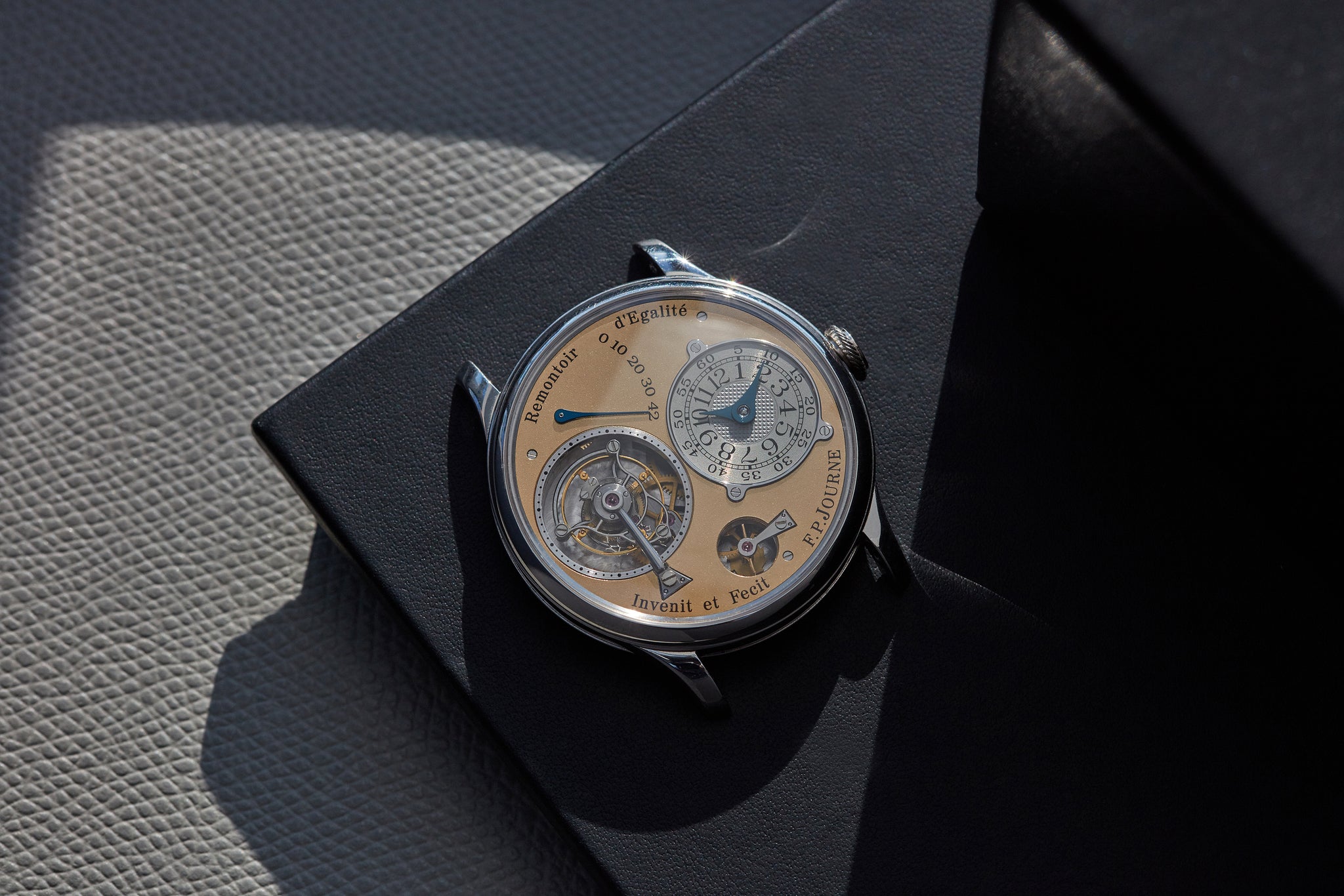MAY 2020
THE STORY OF EARLY F.P. JOURNE
By A Collected Man
CHAPTER I OF III
It can be said that François-Paul Journe is one of the most influential watchmakers of the modern era. Alongside a select few craftsmen, he has led the way in combining the inventiveness of late-18th century horology with the creativity that today’s technology affords us. He manages to bring classical style and his own distinct vision together, through brilliance in design and astute mechanical knowhow.
Yet he wasn’t born adjusting escapements or designing calibres. In fact, as many of you may know, he was a fairly rebellious child, so how did he end up as one of the world’s most respected watchmakers? His path to success certainly wasn’t linear. A reflection of his own unconventional journey, when we asked Francois-Paul Journe if he sought any advice in his early days, he simply responded with, “Yes, Jean-Claude Biver told me that in this job 2 + 2 = 6.”
In an attempt to better understand the man and his early work, we have put together a three-part series of articles:
The Story,
The Collectors’ Guide and
The Outliers.
The first, this one, focuses on the story of Francois-Paul Journe up to the creation of his brand, from his time as a rebellious child to displaying his first watches at Baselworld. Indeed, to understand the brand today, you first have to look at Journe’s early life, from learning his trade at the Ecole d’horlogerie de Paris, to the time spent under the tutelage of his Uncle Michel. This led him to his first ventures into independence, completing commissions for the likes of Asprey of London and Cartier, eventually establishing his own brand with a unique fundraising technique.
The second part is a Collectors’ Guide to early F.P. Journe watches, covering in great detail the first three models released by the young brand: the Tourbillon Souverain, Chronomètre à Resonance and Octa Reserve de Marche. All originally produced with brass movements, we hope to offer some guidance to these early, foundation models. We will be separating each of them into the various generations that have been identified, and outlining the differences between them, from the shimmer of the dial, to the engravings on the caseback. We will also share rich and diverse imagery, assembled from the brand, collectors, auction houses and our own research, to offer a detailed, as well as visual, guide.
The third, and final, part will focus on the special editions, series and unique pieces produced in the first years of the brand. Having covered the story of the man and a guide to his early production pieces, it only felt right to cover the outliers which have emerged.
For this specific chapter, we especially like to thank Pierre Halimi, William Massena, Gino Cukrowicz, Osama Sendi (The Journe Guy), Rexhep Rexhepi, Felipe Joardão, and Michael Hickox for their time and insights. With the above having been outlined, let us dive straight into the story of early F.P. Journe.
THE EARLY LIFE OF FRANÇOIS-PAUL JOURNE
There was a lot happening in 1957. Dwight D. Eisenhower signed the Civil Rights Act and Omega released its trilogy of professional timepieces. But more importantly for the sake of this article, it was the year that François-Paul Journe was born, in the buzzing metropolis of Marseille, in southern France. Journe wasn’t born into a long watchmaking dynasty, nor was he a natural academic. After leaving school at the age of 14, it was clear that further studies were not a path that he planned to follow. In slight desperation, his mother sent him to spend the summer with his uncle, Michel Journe, a vintage clock restorer with a workshop in Paris. What a choice that turned out to be.
Michel wasn’t just any clock restorer, but came from a rarer breed of which there were only a handful left. He possessed the knowledge and mechanical skill to work on some of the most complex and refined mechanisms in the world, made by the likes of Janvier and Breguet. Even Edmond de Rothschild trusted him to look after his clocks. By all accounts, he was also an incredibly enthusiastic man, with a contagious passion for work.
A young François-Paul Journe at his workbench in 1987, Paris.
The young man clearly showed promised, as in 1972, his Uncle managed to persuade Journe’s mother to send him to the Lycée Laperrine d’apprentissage technique (Laperrine School of technical training) to study horology. After nearly two years of study, Journe’s troublemaking past caught-up with him and he was expelled. Following this, he was quickly advised to pick another profession, despite remaining top of all of his classes.
Luckily for us, Journe didn’t take this advice to heart. Instead of dropping horology all together, he made the move from Marseille to Paris, where Michel had just opened a new workshop on the Rue de Verneuil. From there, he could apply what he continued to learn at the École d'horlogerie de Paris and complete the last two years of his horological studies. It was certainly not a trivial decision to take for a teenager, to leave his mother and home, but we think it’s safe to say that this was not a decision that he would later regret.
Upon receiving his diploma in 1976, he joined his uncle’s workshop as a full-time employee. No longer a student, he was undertaking his own tasks and was expected to work to the high standards set by Michel and his demanding clients. One of these was Sir Cecil Clutton, an astute collector of many things, as well as an author of several discerning books on horology. Rather famously, Sir Clutton would often be seen with two pocket watches on him, one from Breguet made in 1823 and the other made by George Daniels for him in 1969.
The pocket watch made for Sir Cecil Clutton by George Daniels, which would have piqued a young Journe's interest in tourbillons early on.
Both were tourbillons of impressive quality and seeing these two timepieces next to each other, clearly had an effect on the young Journe. This was a rather uncommon complication for the time, one which few watchmakers had tackled. The impact of this experience on the young Journe was lasting. As
Rexhep Rexhepi, a celebrated independent watchmaker who worked for Francois-Paul Journe, puts it,
“He developed a lot of respect for Breguet and Daniels because they pushed horology forwards. They built and invented a lot of the things which have a lasting influence today. As a creator himself, it is natural for Journe to respect those other watchmakers who have created. There is a lot of inspiration and influence from both watchmakers in his work.”
Another noteworthy experience from the time spent in his Uncle’s workshop, that would influence his later creations, was when Journe first came across the phenomenon of resonance. In 1982, he was given the opportunity to restore the Breguet No. 3177, that then lived inside the Arts et Métiers Museum in Paris. His journey into resonance had begun. Integrating the phenomenon into a watch would be a quest of his, for years to come.
THE DESIRE TO INVENT AND MAKE
As the young Journe’s work in his uncle’s workshop kept him busy, it was becoming clear that creating something for himself, was of greater interest than restoring the antique clocks that filled the shop. With his fascination in tourbillons having emerged, and lacking the funds to buy one for himself, he decided to make one on his own. A natural first step, Journe went out and bought a copy of The Art of Breguet by George Daniels. Using this seminal book and some tutoring from his uncle, he meticulously assembled his very first watch.
A young François-Paul Journe, stood with his uncle Michel, in his workshop in Paris in 1979 - surrounded by just a few of the intricate clocks they would work on together.
As you might imagine, this was not a quick or easy process. Journe didn’t have the luxury of being able to concentrate on the project full-time, as he still had to work at his Uncle’s shop. He also started to attract outside commissions, keeping him even busier. As a result, it took him roughly five years to complete his first tourbillon.
Just as Journe had started working on his first pocket watch, in 1978, Michel was approached by a client of his, P.G. Brun, with a special request. A company specialising in high-end jewellery and fine clocks, they were in search of someone to construct the mechanism for a planetarium that Asprey of London had commissioned. This was a challenge unlike anything else that the young 22-year-old had faced before.
By this point, Journe was therefore working full-time at his uncle’s shop, trying to build his first watch, constructing a planetarium for an important client, all the while hoping to maintain a relationship and some form of social life. Undoubtedly a lot for anyone to manage, it does give us a sense of just how driven and dedicated Journe was, from a young age. To help with this sizeable project that had a looming deadline, Journe would recruit the help of his uncle and their good friend Cas.
The completed Planetarium that Journe, his uncle and Cas helped build, resplendent in diamonds and rubies, with the 12 signs of the Zodiac cast in gold on top.
While Francois-Paul and Michel set to work on the upper mechanics, Cas was tasked with the motor that sat beneath. The story goes that Journe went over to see Cas, to try and synchronise their work, in order to put it together, but when he arrived, he discovered that Cas hadn’t yet begun. So, in typical Journe fashion, the young watchmaker took charge of the project and worked with Cas to build the motor and timing system in double quick time. They managed to deliver the planetarium on schedule. After it was set with diamonds and rubies, it was presented at Basel World, in 1979.
By January 1983, at just 25 years old, Journe had completed his first watch. It was a rather impressive feat, to have not only constructed a working movement from scratch, but for it to include a tourbillon with twin barrels and a détente escapement too. At a time when students who went to watchmaking school were primarily being taught watch restoration, and not construction or design, this was no small accomplishment. With this watch, Journe was now able to get the attention of the collectors and connoisseurs that could unlock his potentially promising career as a watchmaker.
Journe's first attempt at creating a pocket watch from scratch, complete with blued screws, double-barrel springs and a tourbillon.
It didn’t take Journe long to get a commission to make a pocket watch for a paying client. Just one year later, in 1984, he had completed a pocket watch for Raymond Vogel, which attempted to integrate the phenomenon of resonance. This is explained by Francois-Paul Journe himself in the following terms, “In a watch, never mind which, there is energy which dissipates. When you listen to a watch, the tic-tac of the balance is dissipating energy. In a resonance chronometer, there are two balance wheels which are placed sufficiently close to one another, and the dissipated energy of each is caught by the other, leading to a unique type of frequency regulation.”
The term resonance was not used at this time and would only be coined later, but the principle was very much the same. Unfortunately, the watch didn’t work quite as well as it should have. After all, this was only his second watch, yet he was attempting to produce a complication that had not been made in a pocket watch for almost 200 years.
In a
talk given to the Horological Society of New York, Journe himself admitted that, “It didn’t work because I didn’t have sufficient experience to achieve such a thing. However, I was convinced that one day, I would attempt it again." Attempt and succeed he would. Today, sadly, all that is left of the watch is a dismantled movement that sits in a drawer in Journe’s workshop.
All that is left of Journe's first try at mastering resonance, which now sits in a drawer in his workshop.
The journey kept going. In 1985, he made the decision to take a risk, by opening a workshop. Properly established, Journe let his creativity flourish. Over the next five years, he would take on unique commissions, such as a pocket watch with a fusée and chain and a five second remontoire, as well as a planetary pocket watch.
One of the most significant projects that he completed in this period was a series of Sympathique clocks for
Asprey of London; yet another classic Breguet piece that Journe would attempt to not only recreate, but improve upon. While Breguet’s original could set and regulate a pocket watch, it needed daily-winding. With Journe’s design it could run for eight days on a single wind. These clocks would all end-up in the vast collection of the Sultan of Oman.
THE FIRST WRISTWATCH
Up until this point, everything that Journe had produced either sat on a table-top or in a pocket, but nothing compact enough to fit on the wrist. However, that didn’t stop the young watchmaker from pitching a wrist-worn tourbillon to Breguet, to go alongside the Sympathique clocks that he made for them. While Breguet turned down the request, Journe still produced three prototype tourbillon watches. The very first was numbered 11/91 on the dial, showing that it was completed in 1991. This would go on to be his personal watch after he displayed it that year, to somewhat underwhelming reception, at the Académie Horlogère des Créateurs Indépendants (AHCI) booth in Baselworld.
Journe's very first wristwatch, which not only held a tourbillon of his own design, but more impressively a remontoire, visible at 6 o'clock on the dial.
The struggle to have his work recognised increasingly motivated Journe to create for himself. Even when the established brands or groups commissioned work from him, he wouldn’t be recognised for his efforts. As Pierre Halimi, a friend of Journe’s for over 30 years and the current General Manager for the brand in North America, tells us,
“Francois-Paul was driven crazy, because he fought to have his models accepted by the established brands, designed and made them, handed them over and then the brand and its marketing department controlled everything. He had no leverage.”
What further frustrated Journe, according to Halimi, was the unwillingness of these major brands to give credit to the artisans it worked with, “the brands decided the hide who was behind the work, and rather make it seem like it was just their own efforts.” A notable exception was Harry Winston, with
Max Busser at the helm, which collaborated with Journe as part of the Opus Series. Naturally, his overall frustration propelled Journe forwards.
Journe at the AHCI stand at the 1986 Basel Fair with Franck Muller, George Daniels and Svend Andersen among others.
It seemed natural that his first wristwatch would be a tourbillon, just like his first pocket watch. However, it also integrated a remontoire system, described by watchmaker Rexhepi as “wonderfully ingenious.” This was the first time this constant force mechanism had been seen in a wristwatch. Invented by George Harrison for his H2 marine chronometer, and later perfected by Journe and watchmaker Derek Pratt separately, it would become a signature component of F.P. Journe watches to come. This platinum cased, gold movement tourbillon with remontoire had an oversized aperture showcasing Journe’s craftsmanship in tourbillon construction, as well as a more discrete one for the remontoire.
Osama Sendi, otherwise known as
“The Journe Guy”, an expert on F.P. Journe who has been studying the heritage of the brand for the past several years, shared with us the rationale behind this particular layout for a tourbillon. The watchmaker chose to display the hours and minutes in a smaller subdial on the right-hand side of the case. This was done so that he could discretely glance at the time, by letting the watch protrude slightly from under his cuff, and therefore not appear rude when checking his watch in the company of others.
Further, according to Sendi, visually separating the time indication and the tourbillon was also meant to emphasise the importance of timekeeping. As he puts it, “By splitting the two, you show that they’re equally as important. Time is given importance, as opposed to blending in.”
Journe's third wristwatch prototype, integrating a different style of power reserve to his first two pieces, which were practically identical.
It was in 1994, when out for lunch on a hot day with a couple of friends, that inspiration struck Journe. As the young hostess of the restaurant welcomed them, she supposedly exclaimed “What’s that watch you’re wearing? It’s magnificent!” Of course, it was the tourbillon with remontoire. Regardless of whether the impact of this interaction is overstated or not, it supposedly crystallised an idea that was already forming in Journe’s mind: founding his own brand.
THE SOUSCRIPTION TOURBILLON
Armed with this burst of confidence, the more practical aspects of starting a manufacture needed to be determined. First, there was the small problem of not having a location. While his workshop in Paris was good for creating prototypes, it couldn’t produce a full run of watches. Luckily, there was a central Geneva workshop coming up for sale, in the rue des Maraîchers, which was the perfect size for what he needed and just about in budget. An incessant inventor with countless projects, Journe had many ideas for new creations, and now, he also had the site to produce them on. The only thing that was missing was the funding.
One day, while out to lunch with his friend Camille Berthet, he shared his financial concerns. He explained that he wanted to launch his own line of watches, however the money he was making from his work with Cartier at the time, wasn’t enough to do so. Then, in a move that would come to build the foundation of the brand, Berthet suggested a subscription model. The idea was simple. A few trusting clients would put the money forward for a watch that was yet to be made. In exchange for this good faith, they would receive a discount on its retail value, allowing Journe to raise just enough money to then make more watches and sell them at full value to paying customers.
A Souscription Tourbillon, which we were fortunate enough to handle.
No other brand was offering a watch like this at the time. In fact, there were so few tourbillons on the market, that this on its own would hopefully help attract serious collectors. Giving subscribers a 50% discount on the future retail price of the watch would negate any potential profit that Journe could have made, but it would certainly cover all of his costs. Not only would this allow production to get underway, but the collectors would almost act as brand ambassadors, showcasing his new watches and growing the profile of the young brand.
The total price for the Souscription was CHF 27,500, excluding VAT. From our understanding, the 50% deposit was due mid-way through 1998, with the watches being delivered throughout 1999. Early technical drawings of the Souscription Tourbillon from 1998 are signed by “T.I.M. Horlogerie S.A.”, a separate company created by Francois-Paul Journe in 1996, devoted to developing exclusive calibres in the service various brands. It was the powerhouse behind his movement production, prior to his own manufacture.
Though many remain treasured by their original owners, a few of them have come to be owned by collectors fascinated by these early pieces. One such collector is
Michael Hickox, who bought a Souscription tourbillon in 2013 from the original owner, a very close friend of Journe’s. The exchange was actively encouraged by Journe himself, as he brokered the deal in his own workshop in Geneva. A mystery to many, Hickox offered us some insight into the profile of one of these early adopters. He tells us,
“The fellow who bought it was a family friend of Journe’s. He is older than him and has known him ever since he was a baby. His background is as a clock collector, not a watch collector, and he’s someone that I’ve kept in touch with, actually. I went to Paris last year and had lunch with him.”
For Hickox, the opportunity to own a Souscription Tourbillon is incomparable. A tourbillon by the watchmaker had always been a grail watch for him, so he feels lucky to have been able to track down such an important piece. As he shared with us, “It wasn’t something that people really knew of or valued. Sometimes in this hobby, you get lucky.”
An early design drawing of the Souscription Tourbillon, dated from May 1998.
These first 20 Souscription Tourbillon wristwatches appear, at first, to be very similar to the production Tourbillon Souverain that Journe made from 1999 until 2003. The layout is one we’re now well familiar with: a small dial indicating the time at three o’clock, a power reserve at eleven, and two apertures at nine and six o’clock. The Souscription is housed in a 38mm platinum case, with a rhodium-plated brass movement. As in the later models, they are numbered on the caseback, however, these also carry their number on the dial, in a XX/20 format.
Arguably, these first models demonstrate as many hand-made details as is possible on a modern watch. In fact, they display a range of inconsistencies and quirks, which clearly bear the mark of Francois-Paul Journe himself. The shallow, inconsistent engravings on the caseback and light marks on the dial are clear signs of meticulous, hand-finishing. For many collectors, these small details are the signs of a handmade watch, forming part of the appeal of these early pieces.
Up close with the hand-finished, shimmery dial on a Souscription Tourbillon.
The dial layout further reinforces the artisanal spirit of the watch, with exposed screws and contrasting surfaces. The origins of the golden dial, used by Journe in many other of his early wristwatches, lie with Journe’s first three prototype watches which he produced in the build-up to the Souscription. These had the sub-dials screwed directly onto the base plate of the movement, which was made of 18K gold. It is interesting that a design feature that has now become so coveted by collectors, started off as a practical consideration in the design of a prototype.
Beyond the characteristics of the watches themselves, the fact that only twenty Souscription watches were made and that they were essentially sold to raise the money needed to start the company, make these very important in the history of the brand.
THE FIRST BASELWORLDS
It’s 1999. At the turn of the millennium, Journe is about to announce his eponymous brand to the world at the Basel Fair. Encouraged by those close to him, F.P. Journe only displayed an early version of his Tourbillon at the AHCI booth. This first public exposure reminds us just how different his vision was, when compared to the trends at the time.
William Massena, an industry veteran, former CEO of Antiquorum and close friend of Francois-Paul Journe was there. Sharing his experience with us, he says, “At the time the trends were for chronograph watches, especially with the launch of the Datograph. Big dials with visual complications, big numerals like the Grande Date from Lange and the retrograde from Dubuis and Franck Muller."
He also reminded us that this was the heyday for large watches. With the launch and success of Panerai, many brands were leaning into big and bold design choices, with highly-legible dials. The 38mm pieces that Journe was showing, with only a quarter of the dial space set aside for telling the time, went very much against the grain. Even Massena had to admit “the watches were unlike anything I had seen before.”
An advertisement featuring an early Tourbillon Souverain, featuring many of the first retailers for the brand, as well as their telephone numbers. Of course, Cukrowicz's and Halimi's retail points are displayed.
This somewhat defiant attitude towards trends and the established way of thinking, led Massena to ask Journe the first question, in the watchmaker’s first-ever press conference: “Why did you decide to launch your own brand?” Massena admits that he didn’t see why the world needed another one. Since Harry Winston had released the Opus 1 that same year, with a Journe tourbillon inside it, it also seemed a tad confusing for the casual consumer. However, in what would come to be known as typical Journe fashion, he answered the question thus:
“Parce qui j'en ai marre de donner du caviar à des cochons!”
(“Because I am fed up of giving caviar to swine!”)
The interest in these early tourbillons from the suppliers and retailers was instant. This gave them the confidence to exhibit the next year at Basel Fair, but from their own stand this time, stepping-out of the shadow of the AHCI, alongside whom they’d previously exhibited.
Gino Cukrowicz, Journe’s long-term friend, one of the first retailers for the brand and a shareholder in Montres Journe SA, was there. Essentially a right-hand man to Journe from the early days, Cukrowicz told us that they had three different models on display: the Tourbillon Souverain, the Chronomètre à Resonance and a Grande et Petite Sonnerie. The last model was essentially a unique piece, made with a leftover movement that Journe had designed for Piaget.
Cukrowicz fondly remembers the 2000 Baselworld, telling us, “what I found incredible was that one of our first customers, who was a jeweller, purchased the Grande Sonnerie, without hesitating! Along with a Tourbillon and a Resonance.” The Grande Sonnerie eventually found its way into the collection of the Sultan of Oman. At this Baselworld, Cukrowicz estimates that they sold 100 Tourbillons and 100 Resonances. As he puts it, “we were building up a network. At that time, we did not have boutiques, so it was all through retailers. I think we must’ve had about 40 to 50 retailers all over the world.” It’s worth reminding ourselves, that with the exception of the Souscription Tourbillon, in the early days the vast majority of Francois-Paul Journe’s watches were sold through retailers, rather than by the man himself.
The unique Grande et Petite Sonnerie, from the collection of the late Sultan of Oman.
In these early days, even figuring out how to price their watches was a learning curve for the young brand. In the first two days of Baselworld, they raised their prices three times, after realising they were too cheap. Cukrowicz mentions that, during some visits from retailers, “they did not know I spoke other languages. I could understand that one of them said, ‘Oh, those are the buying prices?’, when I had actually given them suggested retailer prices for their stores.” He quickly ran to the office of one of his partners and insisted they had to raise their prices.
When asked how he broke the news to those retailers who’d already committed at a lower purchasing price, Cukrowicz simply said, “I phoned them up, they all started laughing and they just accepted it.” After all, even at a higher level, the amount of watchmaking received for the money made complete sense for many. Even after increasing their prices three times, F.P. Journe was still cheaper than Patek Philippe, Vacheron Constantin or Audemars Piguet.
LAYING THE FIRST BRICK
That first two fairs marked a turning-point in Francois-Paul Journe’s career. His journey into independence was no longer a dream. At the time, prior to becoming the General Manager for F.P. Journe in North America, Pierre Halimi was a retailer for a few unusual independent watchmakers in the United States. He echoes the gradual excitement that was building around Journe’s watches.
As the two men were friends, the watchmaker approached him in 1999 with five early tourbillon wristwatches to sell from his retail point in Miami. Halimi shared with us that, “I didn't take the five watches in my store in Palm Beach. Not because I didn’t think I could sell them, but because I wanted to get the word out about Journe and his work.”
A close up on an early Chronomètre à Resonance.
Therefore, despite Journe reminding him that he would make less money in doing so, Halimi decided to place the five watches with five different retailers in Aspen, Chicago, Sun Valley, Carmen and keeping the last one for his own store. By doing so, Halimi helped build the foundations for what continues to be one of F.P. Journe’s most important global markets. Reflecting on the experience, he tells us,
“In 1999, we saw that we could penetrate the market. I was one of the first retailers of Franck Muller in the United States. Though the watches couldn’t be more different from what Francois-Paul makes, I saw that consumers were ready to listen to other languages.”
Halimi echoes Cukrowicz’s sentiment that the pricing of the original models delivered an impressive amount of horology for the money. In the United States, the original retail price of the tourbillon was $59,000. For a tourbillon wristwatch of this calibre, it seems like a bargain – even more so today. Halimi remembers Journe telling him early on, “People don't know me, people don't even know what a Tourbillon is.”
His reasonable pricing at this juncture is a testament to one of Journe’s unspoken qualities: his pragmatism when it comes to running a business. Rexhepi, himself having wrestled with the difficulty of setting up an independent brand with AKRIVIA, respects this quality. As he himself puts it, “Journe doesn’t just think like a watchmaker. He has a well-rounded reflection. He is thoughtful about design, complication and the way he structures his collections.” Indeed, beyond his brilliance as a watchmaker, Journe’s sense of how to create and sustain a business has been a key determinant in his success.
An early Tourbillon Souverain, one of three foundational models of the brand.
This definitely resounded with collectors. According to
Felipe Joardão, who has been collecting F.P. Journe for over twenty years and was one of the first to document the variations in the early models, when he first saw the watches, the impact was immediate.
As he puts it, “What really blew me away was the first time I walked into Cellini, in New York, and saw the three pieces. The Tourbillon, the Resonance and the Octa Reserve de Marche. It was something that drew my eye. It was traditional like Breguet, but at the same time modern and technically advanced.” Even though he couldn’t afford the pieces at the time, the influence of these pieces was enduring. He would eventually seek out the most perfect example of all three he could find. Twenty years later, the passion is still as all-consuming.
We would like to thank those who have been of great assistance in putting this three-part series together. Their generosity, both with their knowledge and their time, is greatly appreciated. We would especially like to thank Pierre Halimi, William Massena, Gino Cukrowicz, Osama Sendi (The Journe Guy), Rexhep Rexhepi, Felipe Joardão, SJX, Shawn Mehta, Michael Hickox and Anthony Kingsley.
We would also like to thank Francois-Paul Journe himself for providing a quote for this article, as well as the brand for providing us with a rich collection of archival photographs. Equally, we are grateful to Christie’s, Sotheby’s, Phillips and Antiquorum for making their imagery accessible. We would also like to reference the book F.P. Journe – Invenit et Fecit, by Jean-Pierre Grosz, as a rich resource for the early life of Francois-Paul Journe.







